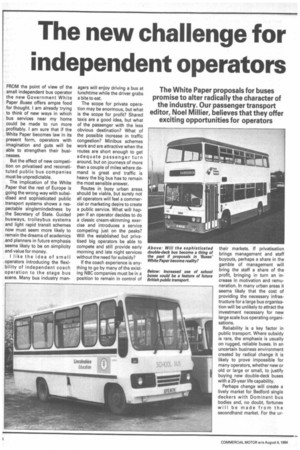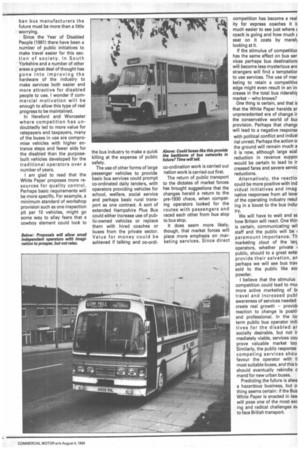The new challenge for independent operators
Page 36

Page 37

If you've noticed an error in this article please click here to report it so we can fix it.
FROM the point of view of the small independent bus operator the new Government White Paper Buses offers ample food for thought. I am already trying to think of new ways in which bus services near my home could be made to run more profitably. I am sure that if the White Paper becomes law in its present form, operators with imagination and guts will be able to strengthen their businesses.
But the effect of new competition on privatised and reconstituted public bus companies must be unpredictable.
The implication of the White Paper that the rest of Europe is going the wrong way with subsidised and sophisticated public transport systems shows a respectable singlemindedness by the Secretary of State. Guided busways, trolleybus systems and light rapid transit schemes now must seem more likely to remain the dreams of academics and planners in future emphasis seems likely to be on simplicity and value for money.
I like the idea of small operators introducing the flexibility of independent coach operation to the stage bus scene. Many bus industry man
agers will enjoy driving a bus at lunchtime while the driver grabs a bite to eat.
The scope for private operation may be enormous, but what is the scope for profit? Shared taxis are a good idea, but what of the passenger with the less obvious destination? What of the possible increase in traffic congestion? Minibus schemes work and are attractive when the routes are short enough to get adequate passenger turn around, but on journeys of more than a couple of miles where demand is great and traffic is heavy the big bus has to remain the most sensible answer.
Routes in busy urban areas should be viable, but surely not all operators will feel a commercial or marketing desire to create a public service. What will happen if an operator decides to do a classic cream-skimming exercise and introduces a service competing just on the peaks? Will the established but privatised big operators be able to compete and still provide early morning and late night services without the need for subsidy?
If the coach experience is anything to go by many of the existing NBC companies must be in a position to remain in control of their markets. If privatisation brings management and staff buyouts, perhaps a share in the gamble of management will bring the staff a share of the profit, bringing in turn an increase in motivation and remuneration. In many urban areas it seems likely that the cost of providing the necessary infrastructure for a large bus organisation will be unlikely to attract the investment necessary for new large scale bus operating organisations.
Reliability is a key factor in public transport. Where subsidy is rare, the emphasis is usually on rugged, reliable buses. In an uncertain business environment created by radical change it is likely to prove impossible for many operators, whether new or old or large or small, to justify buying new double-deck buses with a 20-year life capability.
Perhaps change will create a lively market for Bedford single deckers with Dominant bus bodies and, no doubt, fortunes will be made from the secondhand market. For the ur ban bus manufacturers the future must be more than a little worrying.
Since the Year of Disabled People (1981) there have been a number of public initiatives to make travel easier for this section of society. In South Yorkshire and a number of other areas a great deal of thought has gone into improving the hardware of the industry to make services both easier and more attractive for disabled people To use I wonder if commercial motivation will be enough to allow this type of real progress to be maintained.
In Hereford and Worcester where competition has undoubtedly led to more value for ratepayers and taxpayers, many of the buses in use are cornpromise vehicles with higher entrance steps and fewer aids for the disabled than the purposebuilt vehicles developed for the traditional operators over a number of years, I am glad to read that the White Paper proposes more resources for quality control. Perhaps basic requirements will be more specific. For example, a minimum standard of workshop provision such as one inspection pit per 10 vehicles, might go some way to allay fears that a cowboy element could look to the bus industry to make a quick killing at the expense of public safety.
The use of other forms of large passenger vehicles to provide basic bus services could prompt co-ordinated daily tenders, with operators providing vehicles for school, welfare, social service and perhaps basic rural transport as one contract. A sort of extended Hampshire Plus Bus could either increase use of public-owned vehicles or replace them with hired coaches or buses from the private sector. Value for money could be achieved if talking and co-ordi co-ordination work is carried out nation work is carried out first.
The return of public transport to the dictates of market forces has brought suggestions that the changes herald a return to the pre-1930 chaos, when competing operators looked for the routes with passengers and raced each other from bus stop to bus stop.
It does seem more likely, though, that market forces will place more emphasis on marketing services. Since direct
competition has become a real ity for express coaches it I: much easier to see just where coach is going and how much E seat on it costs by merel) looking at it.
If the stimulus of competitior has the same effect on bus ser vices perhaps bus destination: will become less mysterious anc strangers will find a temptatior to use services. The use of mar keting to retain a competitivE edge might even result in an in crease in the total bus ridershir market — who knows?
One thing is certain, and that that the White Paper heralds ar unprecedented era of change ir the conservative world of bu: provision. Perhaps that changE will lead to a negative response with political conflict and indus1 rial unrest. Perhaps the action a the ground will remain much a it is now, although large seal reduction in revenue suppoi would be certain to lead to ir creased fares and severe servic reductions.
Alternatively, the reactio could be more positive with ind vidual initiatives and imag native responses from all level of the operating industry resul ing in a boost to the bus indui try.
We will have to wait and SE how Britain will react. One thin is certain, communicating wil staff and the public will be paramount importance. Th marketing clout of the !arc operators, whether private public, should to a great extel provide their salvation, an perhaps we will see bus tray sold to the public like sok powder.
I believe that the stimulus competition could lead to mt.8 more active marketing of bi travel and increased publ awareness of services needed create real growth — providi reaction to change is positi. and professional. In the loi term public bus operator initi tives for the disabled ar socially desirable, but not in mediately viable, services cou prove valuable market too Similarly, the public response competing services shou favour the operator with ti most suitable buses, and this ti should eventually rekindle mand for new urban buses.
Predicting the future is alwa a hazardous business, but o thing seems certain: if the Bus White Paper is enacted in la% will pose one of the most exc ing and radical challenges e% to face British transport.
























































































